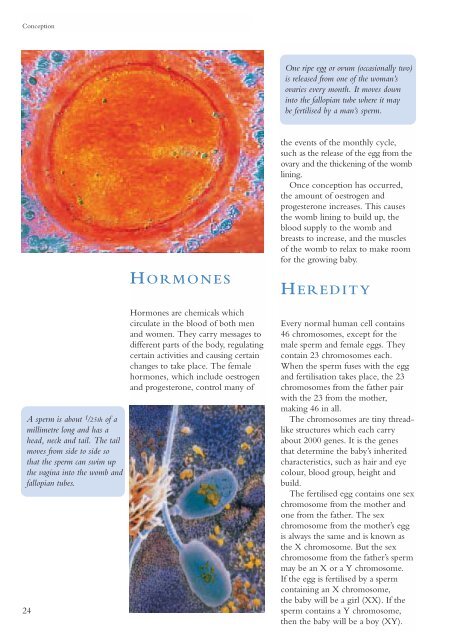here - Health Promotion Agency
here - Health Promotion Agency
here - Health Promotion Agency
Create successful ePaper yourself
Turn your PDF publications into a flip-book with our unique Google optimized e-Paper software.
Conception<br />
One ripe egg or ovum (occasionally two)<br />
is released from one of the woman’s<br />
ovaries every month. It moves down<br />
into the fallopian tube w<strong>here</strong> it may<br />
be fertilised by a man’s sperm.<br />
A sperm is about 1 /25th of a<br />
millimetre long and has a<br />
head, neck and tail. The tail<br />
moves from side to side so<br />
that the sperm can swim up<br />
the vagina into the womb and<br />
fallopian tubes.<br />
24<br />
H ORMONES<br />
Hormones are chemicals which<br />
circulate in the blood of both men<br />
and women. They carry messages to<br />
different parts of the body, regulating<br />
certain activities and causing certain<br />
changes to take place. The female<br />
hormones, which include oestrogen<br />
and progesterone, control many of<br />
the events of the monthly cycle,<br />
such as the release of the egg from the<br />
ovary and the thickening of the womb<br />
lining.<br />
Once conception has occurred,<br />
the amount of oestrogen and<br />
progesterone increases. This causes<br />
the womb lining to build up, the<br />
blood supply to the womb and<br />
breasts to increase, and the muscles<br />
of the womb to relax to make room<br />
for the growing baby.<br />
H EREDITY<br />
Every normal human cell contains<br />
46 chromosomes, except for the<br />
male sperm and female eggs. They<br />
contain 23 chromosomes each.<br />
When the sperm fuses with the egg<br />
and fertilisation takes place, the 23<br />
chromosomes from the father pair<br />
with the 23 from the mother,<br />
making 46 in all.<br />
The chromosomes are tiny threadlike<br />
structures which each carry<br />
about 2000 genes. It is the genes<br />
that determine the baby’s inherited<br />
characteristics, such as hair and eye<br />
colour, blood group, height and<br />
build.<br />
The fertilised egg contains one sex<br />
chromosome from the mother and<br />
one from the father. The sex<br />
chromosome from the mother’s egg<br />
is always the same and is known as<br />
the X chromosome. But the sex<br />
chromosome from the father’s sperm<br />
may be an X or a Y chromosome.<br />
If the egg is fertilised by a sperm<br />
containing an X chromosome,<br />
the baby will be a girl (XX). If the<br />
sperm contains a Y chromosome,<br />
then the baby will be a boy (XY).
















